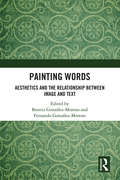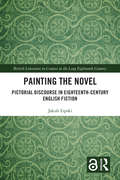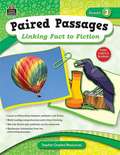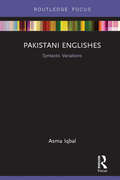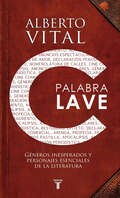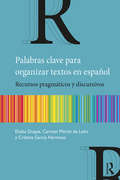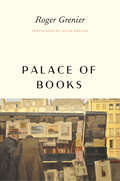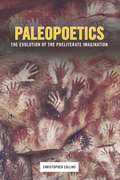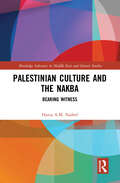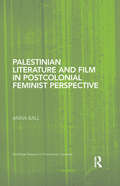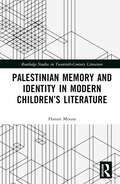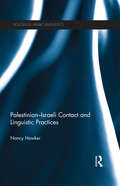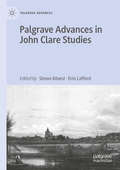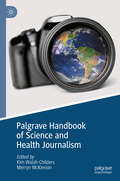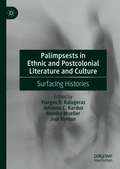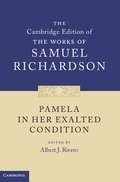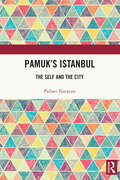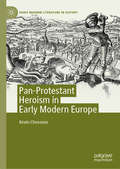- Table View
- List View
Painting Words: Aesthetics and the Relationship between Image and Text (Routledge Interdisciplinary Perspectives on Literature)
by Beatriz González-Moreno Fernando González-MorenoPainting Words: Aesthetics and the Relationship between Image and Text addresses the importance of dialogue between art and literature, text and image in our image-saturated era. In a globalized world, isolation and compartmentalization hinder us back, whereas the Romantic idea of belonging urges us to look beyond and to build bridges. Bearing this Romantic spirit in mind, rather than focusing on a traditional paragonal approach, this book puts forward the benefits of alliance by offering an interdisciplinary and transdisciplinary perspective. Illustrations are included to guide the reader into comparativism and intermedial encounters, while providing an inspiring overview of the literary and visual department both in Europe and America from the Renaissance to the twentieth century. The different essays lead us through an aesthetic exploratory journey by the hand of Cervantes, Shakespeare, Felicia Hemans, Emily Eden, William Wordsworth, Edgar A. Poe, Flannery O’Connor, N. Scott Momaday, José Joaquín de Mora, Wallace Stevens and José Ángel Valente, among others. Editors, Beatriz González Moreno and Fernando González Moreno have brought together an international group of scholars around the idea of "painting words," which they define as the pictorial ability of language to stir the reader’s imagination and the way illustrators have "read" literary works over the course of centuries. Many traditional comparative studies examine literature belonging to specific time periods or movements, far less frequently do they bridge visual culture with text-- Painting Words: Aesthetics and the Relationship between Image and Text aims to do just that.
Painting the Novel: Pictorial Discourse in Eighteenth-Century English Fiction (British Literature in Context in the Long Eighteenth Century)
by Jakub LipskiPainting the Novel: Pictorial Discourse in Eighteenth-Century English Fiction focuses on the interrelationship between eighteenth-century theories of the novel and the art of painting – a subject which has not yet been undertaken in a book-length study. This volume argues that throughout the century novelists from Daniel Defoe to Ann Radcliffe referred to the visual arts, recalling specific names or artworks, but also artistic styles and conventions, in an attempt to define the generic constitution of their fictions. In this, the novelists took part in the discussion of the sister arts, not only by pointing to the affinities between them but also, more importantly, by recognising their potential to inform one another; in other words, they expressed a conviction that the theory of a new genre can be successfully rendered through meta-pictorial analogies. By tracing the uses of painting in eighteenth-century novelistic discourse, this book sheds new light on the history of the so-called "rise of the novel".
Pakistani Englishes: Syntactic Variations
by Asma IqbalThis book explores how non-native speakers, especially in postcolonial states, use English to communicate. Focusing on Pakistan, the monograph analyzes word categories, phrase and sentence structures used in the region and compares them to British English. It draws extensively from language used in the media and uses Lexical Functional Grammar (LFG) parsers to develop the phrase structures for qualitative analysis and a manual approach to quantify the frequency of various types of phrases. The volume also highlights the possible reasons for the differences and locates language use in context. The volume will be of great interest to researchers, scholars, and teachers interested in linguistics, especially sociolinguistics, postcolonial studies, critical theory, media studies and World Englishes.
Palabra clave
by Alberto VitalPalabra clave nos invita a viajar, de la mano de grandes personajes, a través de diversos géneros de la literatura. Alberto Vital analiza dos grandes ámbitos de la creación. En la primera parte, se adentra en los géneros literarios, los grandes e innegables pero también los que no han sido tomados como tales: la indispensable declaración amorosa o el epíteto, entre otros. Y unos más contemporáneos como la declaración ministerial; y el género "pastilla", representado por la publicidad, las pintas en las calles y los pies de foto, que describen puntualmente la sociedad de lo inmediato en la que vivimos. También analiza los bestiarios de Jorge Luis Borges, Juan José Arreola y Julio Cortázar; y muestra al ensayo como una tabla de salvación al permitir abordar un tema desde tantas y diversas perspectivas.En la segunda parte, el autor reflexiona sobre los personajes más representativos de la literatura universal: la perspectiva infantil que se revela en el Kim de Kipling, las criaturas shakesperianas, los autores que se transforman en personajes, la conversión del poeta en un personaje o, bien, aquellos que, a la manera del joven Holden Caulfield, casise vuelven omnipresentes en la vida de los lectores. Palabra clave nos invita a descubrir cómo la Maga salta de Rayuela para convertirse en una nueva Dulcinea y Oskar Matzerath se fuga de El tambor de hojalata para ir en busca de Moby Dick. Un viaje lúdico que bien vale la pena intentar.
Palabra clave: Géneros inesperados y personajes esenciales de la literatura
by Alberto VitalPalabra clave nos invita a viajar, de la mano de grandes personajes, a través de diversos géneros de la literatura. Alberto Vital analiza dos grandes ámbitos de la creación. En la primera parte, se adentra en los géneros literarios, los grandes e innegables pero también los que no han sido tomados como tales: la indispensable declaración amorosa o el epíteto, entre otros. Y unos más contemporáneos como la declaración ministerial; y el género "pastilla", representado por la publicidad, las pintas en las calles y los pies de foto, que describen puntualmente la sociedad de lo inmediato en la que vivimos. También analiza los bestiarios de Jorge Luis Borges, Juan José Arreola y Julio Cortázar; y muestra al ensayo como una tabla de salvación al permitir abordar un tema desde tantas y diversas perspectivas. En la segunda parte, el autor reflexiona sobre los personajes más representativos de la literatura universal: la perspectiva infantil que se revela en el Kim de Kipling, las criaturas shakesperianas, los autores que se transforman en personajes, la conversión del poeta en un personaje o, bien, aquellos que, a la manera del joven Holden Caulfield, casi se vuelven omnipresentes en la vida de los lectores. Palabra clave nos invita a descubrir cómo la Maga salta de Rayuela para convertirse en una nueva Dulcinea y Oskar Matzerath se fuga de El tambor de hojalata para ir en busca de Moby Dick. Un viaje lúdico que bien vale la pena intentar.
Palabras clave para organizar textos en español: Recursos pragmáticos y discursivos
by Eladio Duque Carmen Martín de León Cristina Garcia HermosoPalabras clave para organizar textos en español: recursos pragmáticos y discursivos está dirigido a estudiantes de español como lengua extranjera –de nivel B2/ C1 (MCER) o Intermediate High/ Advanced Low (ACTFL)– que deseen mejorar la coherencia de sus textos hablados y escritos. En este libro el lector encontrará explicaciones teóricas acompañadas de numerosas actividades en las que pondrá en práctica una gran variedad de estructuras, estrategias y herramientas útiles para conectar frases y párrafos de manera eficaz.Palabras clave para organizar textos en español se fundamenta en el uso de la lengua en contextos de comunicación real. El libro puede utilizarse de manera independiente o como material de clase, ya que, además de las actividades con las que el aprendiz puede autoevaluar su progreso, también incluye actividades abiertas y juegos para trabajar en grupo.
Palabras moribundas
by Álex Grijelmo Pilar García MoutonLas palabras moribundas tienen un poder evocador que lleva hacia nuestra memoria el recuerdo de personas queridas que ya no están, épocas de nuestra vida que pasaron, utensilios perdidos, tareas superadas, antiguas modas divertidas. Este libro puede ser una especie de álbum de fotos familiares para muchas lectores que algún día utilizaron términos como chipén , pasquín, pickup, chiticalla, romadizo, almazuela, córcholis, mandil, encetar, garrotillo, mancar... o elepé o tomavistas. Pasaron por nuestras bocas y nuestros oídos, pero ¿cuánto tiempo hace que usted no oye, lee o pronuncia la palabra desgalichado? Leyendo estos vocablos y recordando sus usos aparecerán de nuevo muchas imágenes que no sospechábamos tan lejanas; y tal vez lamentemos que sus ecos se estén perdiendo. Lo que pretende este libro es que esas palabras no mueran, y que al menos revivan en la memoria de miles de lectores.
Palace of Books
by Alice Kaplan Roger GrenierFor decades, French writer, editor, and publisher Roger Grenier has been enticing readers with compact, erudite books that draw elegant connections between the art of living and the work of art. Under Grenier’s wry gaze, clichés crumble, and offbeat anecdotes build to powerful insights. With Palace of Books, he invites us to explore the domain of literature, its sweeping vistas and hidden recesses. Engaging such fundamental questions as why people feel the need to write, or what is involved in putting one’s self on the page, or how a writer knows she’s written her last sentence, Grenier marshals apposite passages from his favorite writers: Chekhov, Baudelaire, Proust, James, Kafka, Mansfield and many others. Those writers mingle companionably with tales from Grenier’s half-century as an editor and friend to countless legendary figures, including Albert Camus, Romain Gary, Milan Kundera, and Brassai,. Grenier offers here a series of observations and quotations that feel as spontaneous as good conversation, yet carry the lasting insights of a lifetime of reading and thinking. Palace of Books is rich with pleasures and surprises, the perfect accompaniment to old literary favorites, and the perfect introduction to new ones.
Palauan Alphabet (Island Alphabet Books)
by Lori PhillipsThis book is part of the Island Alphabet Books series, which features languages and children's artwork from the U.S.-affiliated Pacific. Each book contains the complete alphabet for the language, four or five examples for each letter, and a word list with English translations. The series is published by PREL, a non- profit corporation that works collaboratively with school systems to enhance education across the Pacific.
Paleopoetics: The Evolution of the Preliterate Imagination
by Christopher CollinsChristopher Collins introduces an exciting new field of research traversing evolutionary biology, anthropology, archaeology, cognitive psychology, linguistics, neuroscience, and literary study. Paleopoetics maps the selective processes that originally shaped the human genus millions of years ago and prepared the human brain to play, imagine, empathize, and engage in fictive thought as mediated by language. A manifestation of the "cognitive turn" in the humanities, Paleopoetics calls for a broader, more integrated interpretation of the reading experience, one that restores our connection to the ancient methods of thought production still resonating within us.Speaking with authority on the scientific aspects of cognitive poetics, Collins proposes reading literature using cognitive skills that predate language and writing. These include the brain's capacity to perceive the visible world, store its images, and retrieve them later to form simulated mental events. Long before humans could share stories through speech, they perceived, remembered, and imagined their own inner narratives. Drawing on a wide range of evidence, Collins builds an evolutionary bridge between humans' development of sensorimotor skills and their achievement of linguistic cognition, bringing current scientific perspective to such issues as the structure of narrative, the distinction between metaphor and metonymy, the relation of rhetoric to poetics, the relevance of performance theory to reading, the difference between orality and writing, and the nature of play and imagination.
Palestinian Culture and the Nakba: Bearing Witness (Routledge Advances in Middle East and Islamic Studies)
by Hania A.M. NashefThe Nakba not only resulted in the loss of the homeland, but also caused the dispersal and ruin of entire Palestinian communities. Even though the term Nakba refers to a singular historic event, the consequence of 1948 has symptomatically become part of Palestinian identity, and the element that demarcates who the Palestinian is. Palestinian exile and loss have evolved into cultural symbols that at once help define the person and allow the person to remember the loss. Although accounts of the Palestinians’ experience of the expulsion from the land are similar, the emblems that provoke these particular memories differ. Certain mementos, memories or objects help in commemorating the homeland. This book looks at the icons, narratives and symbols that have become synonymous with Palestinian identity and culture and which have, in the absence of a homeland, become a source of memory. It discusses how these icons have come into being and how they have evolved into sites of power which help to keep the story and identity of the Palestinians alive. The book looks at examples from Palestinian caricature, film, literature, poetry and painting, to see how these works ignite memories of the homeland and help to reinforce the diasporic identity. It also argues that the creators of these narratives or emblems have themselves become cultural icons within the collective Palestinian recollection. By introducing the Nakba as a lived experience, this book will appeal to students and scholars of Middle East Studies, Cultural Studies, Literature and Media Studies.
Palestinian Literature and Film in Postcolonial Feminist Perspective (Routledge Research in Postcolonial Literatures)
by Anna BallPalestinian Literature and Film in Postcolonial Feminist Perspective is the first sustained study of gender-consciousness in the Palestinian creative imagination. Drawing on concepts from postcolonial feminist theory, Ball analyses a range of literary and filmic works by major creative practitioners including Michel Khleifi , Liana Badr, Annemarie Jacir, Elia Suleiman, Mona Hatoum and Suheir Hammad, and reveals a hitherto unrecognized trajectory in gender-consciousness under development in the Palestinian imagination from the start of the twentieth century. The book explores how these works resonate with questions of power, identity, nation, resistance, and self-representation in the Palestinian imagination more broadly, and asks how these gender-conscious narratives transform our understanding of Palestine's struggle for postcoloniality. Working at the cusp of postcolonial, feminist and cultural enquiry, Ball seeks to open up vital new directions in the interdisciplinary study of Palestine.
Palestinian Memory and Identity in Modern Children’s Literature (Routledge Studies in Twentieth-Century Literature)
by Hanan MousaA timely and significant contribution to Palestinian children’s literature from 1967 to the present day, Palestinian Memory and Identity in Modern Children’s Literature examines a myriad of motifs and popular culture, and the evolution of national identity and consciousness among young Palestinians. Utilizing analytical and in-depth readings, this text presents a thorough examination of the representations and role of folk culture in Palestinian children’s literature from both thematic and stylistic-linguistic perspectives. The analysis covers a wide range of diverse works representing popular culture published after 1967, including diverse works by writers from Israel, the West Bank, Gaza, and the Palestinian diaspora. This volume will be of interest to academics and students exploring the vast contexts of Arabic children’s literature and Palestinian folk lore.
Palestinian-Israeli Contact and Linguistic Practices (Routledge Arabic Linguistics Series)
by Nancy HawkerOffering insight into linguistic practices resulting from different kinds of Palestinian-Israeli contact, this book examines a specific conceptualisation of the link between the political and economic contexts and human practices, or between structure and agency, termed "articulation". The contexts of the military occupation, a shared consumer market, controlled cheap labour migration, and the provision of social services, supply the setting for power relations between Israelis and Palestinians which give rise to a variety of linguistic practices. Among these practices is the borrowing of Hebrew words and phrases for use in Palestinians’ Arabic speech. Hebrew borrowings can demarcate in-groups, signal aspirations to a modern lifestyle, and give a political edge to humour. Nancy Hawker’s explanation for these practices moves away from the notions of conflict and national identity and gives prominence to Palestinian and Israeli ideologies that inform the conceptual experience of Palestinians. Addressing an understudied linguistic situation, Palestinian-Israeli Contact and Linguistic Practices brings us documentation and analysis of recent casework, firmly anchored in empirical results from fieldwork in three refugee camps in the Occupied Palestinian Territories. Combining sociolinguistics with politics, economics, sociology and philosophy this book will be of great interest to students and scholars of Middle East Studies, Linguistics and Political Theory.
Palgrave Advances in John Clare Studies (Palgrave Advances)
by Simon Kövesi Erin LaffordThis collection gathers together an exciting new series of critical essays on the Romantic- and Victorian-period poet John Clare, which each take a rigorous approach to both persistent and emergent themes in his life and work. Designed to mark the 200th anniversary of the publication of Clare’s first volume of poetry, Poems Descriptive of Rural Life and Scenery, the scholarship collected here both affirms Clare’s importance as a major nineteenth-century poet and reveals how his verse continually provokes fresh areas of enquiry. Offering new archival, theoretical, and sometimes corrective insights into Clare’s world and work, the essays in this volume cover a multitude of topics, including Clare’s immersion in song and print culture, his formal ingenuity, his environmental and ecological imagination, his mental and physical health, and his experience of asylums. This book gives students a range of imaginative avenues into Clare’s work, and offers both new readers and experienced Clare scholars a vital set of contributions to ongoing critical debates.
Palgrave Handbook of Critical Posthumanism
by Manuela Rossini Stefan Herbrechter Ivan Callus Marija Grech Megen de Bruin-Molé Christopher John MüllerPalgrave Handbook of Critical Posthumanism is a major reference work on the paradigm emerging from the challenges to humanism, humanity, and the human posed by the erosion of the traditional demarcations between the human and nonhuman. This handbook surveys and speculates on the ways in which the posthumanist paradigm emerged, transformed, and might further develop across the humanities. With its focus on the posthuman as a figure, on posthumanism as a social discourse, and on posthumanisation as an on-going historical and ontological process, the volume highlights the relationship between the humanities and sciences. The essays engage with posthumanism in connection with subfields like the environmental humanities, health humanities, animal studies, and disability studies. The book also traces the historical representations and understanding of posthumanism across time. Additionally, the contributions address genre and forms such as autobiography, games, art, film, museums, and topics such as climate change, speciesism, anthropocentrism, and biopolitics to name a few. This handbook considers posthumanism’s impact across disciplines and areas of study.
Palgrave Handbook of Science and Health Journalism
by Kim Walsh-Childers Merryn McKinnonThis handbook reviews the extant literature on the most important issues in health and science journalism, with a focus on summarizing the relevant research and identifying key questions that are yet to be answered. It explores challenges and best practices in health and science reporting, formats and audiences, key topics such as climate change, pandemics and space science, and the ethics and political impacts of science and health journalist practice. With numerous international contributions, it provides a comprehensive overview of an emerging area of journalism studies and science communication.
Palimpsests and The Literary Imagination of Medieval England
by Leo Carruthers Raeleen Chai-Elsholz Tatjana SilecWitnesses to the disappearance of a text, palimpsest manuscripts bear the marks of their own genesis, with their original inscription rubbed out and written over on the same parchment. This collection explores analogies of erasure and rewriting observed in editorial and literary practices underlying the production of texts from medieval England.
Palimpsests in Ethnic and Postcolonial Literature and Culture: Surfacing Histories
by Jopi Nyman Monika Mueller Johanna C. Kardux Yiorgos D. KalogerasThis volume explores ways in which the literary trope of the palimpsest can be applied to ethnic and postcolonial literary and cultural studies. Based on contemporary theories of the palimpsest, the innovative chapters reveal hidden histories and uncover relationships across disciplines and seemingly unconnected texts. The contributors focus on diverse forms of the palimpsest: the incarceration of Native Americans in military forts and their response to the elimination of their cultures; mnemonic novels that rework the politics and poetics of the Black Atlantic; the urban palimpsests of Rio de Janeiro, Marseille, Johannesburg, and Los Angeles that reveal layers of humanity with disparities in origin, class, religion, and chronology; and the palimpsestic configurations of mythologies and religions that resist strict cultural distinctions and argue against cultural relativism.
Palmetto Leaves (Florida Sand Dollar Books)
by Harriet Beecher StoweIn 1867, the author of Uncle Tom’s Cabin settled in a small cottage in Mandarin, Florida, overlooking the St. Johns River. She had promised her Boston publisher another novel but was so taken with northeast Florida that she produced instead a series of sketches of the land and the people which she submitted in 1872 under the title Palmetto Leaves.Stowe describes life in Florida in the latter half of the 19th century—"a tumble-down, wild, panicky kind of life—this general happy-go-luckiness which Florida inculcates." Her idyllic sketches of picnicking, sailing, and river touring expeditions and simple stories of events and people in this tropical "winter summer" land became the first unsolicited promotional writing to interest northern tourists in Florida.
Pam and the Clam (Word Family Readers)
by Liza CharlesworthLet's Learn Readers boost key literacy skills through engaging, easy-to-read stories. Jump-start phonics learning with these super-fun books! For use with Grades K-2.
Pamela in Her Exalted Condition
by Samuel Richardson Albert J. RiveroPamela in Her Exalted Condition follows the heroine of Richardson's hugely popular first novel into married life. In the process, he explores both the experience of women beyond the stage of courtship and provides a fascinating insight into the social and cultural life of the mid eighteenth century. The first ever scholarly edition of the novel, this volume features a critically edited text, general and textual introductions, full annotations and textual apparatus. Appendices describe all the editions published in Richardson's lifetime as well as early nineteenth-century editions. The original illustrations from the popular octavo edition of 1742 and Richardson's index are reproduced. The publication of this novel in the Cambridge edition allows the sequel to Pamela to take its rightful place in the critical study of Richardson's development as a novelist.
Pamuk's Istanbul: The Self and the City
by Pallavi NarayanThis book reconstructs Istanbul through the prism of Orhan Pamuk’s fiction. It navigates the multiple selves and layers of Istanbul to present how the city has shaped the writings of Pamuk and has, in turn, been shaped by it. Through everyday objects and architecture, it shows how Pamuk transforms the city into a living museum where different objects converse along with characters to present a rich tapestry across space and time. Further, the monograph explores the formation of communal and literary identity within and around nation-building narratives informed by capitalism and modernization. The book also examines how Pamuk uses the postmodern city to move beyond its postmodern confines, and utilizes the theories and universes of Bakhtin, Benjamin, and Foucault to open up his fiction and radically challenge the idea of the novel. The volume will be of great interest to scholars and researchers of literature, literary theory, museum studies, architecture, and cultural studies, and especially appeal to readers of Orhan Pamuk.
Pan-Protestant Heroism in Early Modern Europe (Early Modern Literature in History)
by Kevin ChovanecThis book offers the first full study of the challenges posed to an emerging English nationalism that stemmed from the powerful appeal exerted by the leaders of the international Protestant cause. By considering a range of texts, including poetry, plays, pamphlets, and religious writing, the study reads this heroic tradition as a 'connected literary history,' a project shared by Protestants throughout Northern Europe, which opened up both collaboration among writers from these different regions and new possibilities for communal identification. The work’s central claim is that a pan-Protestant literary field existed in the period, which was multilingual, transnational, and ideologically charged. Celebrated leaders such as William of Orange posed a series of questions, especially for English Protestants, over the relationship between English and Protestant identity. In formulating their role as co-religionists, writers often undercut notions of alterity, rendering early modern conceptions of foreignness especially fluid and erasing national borders.
